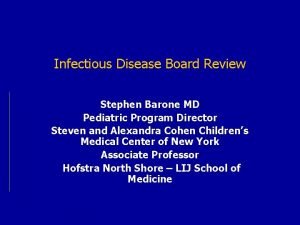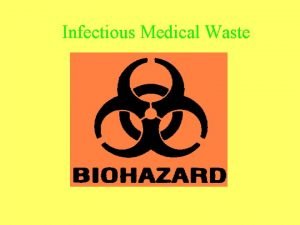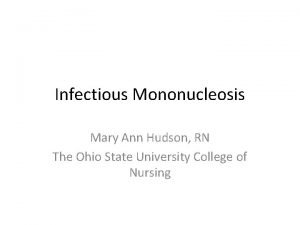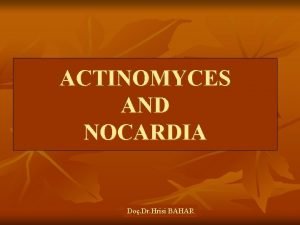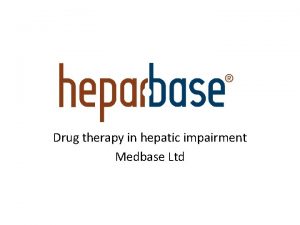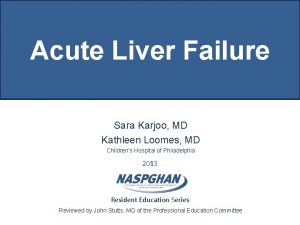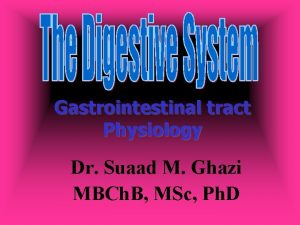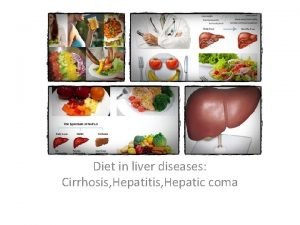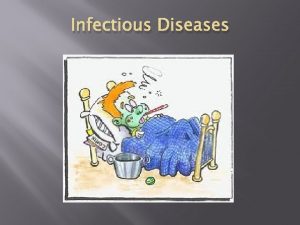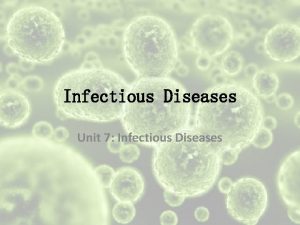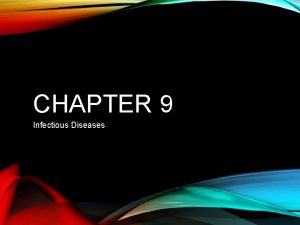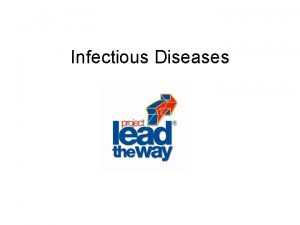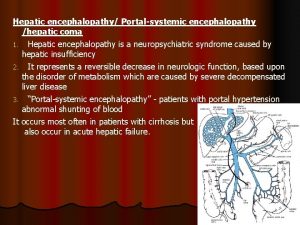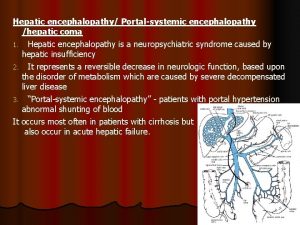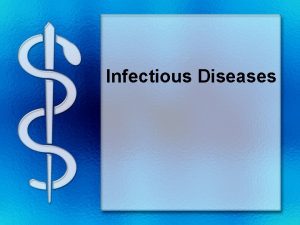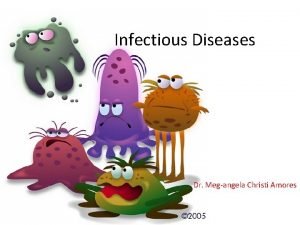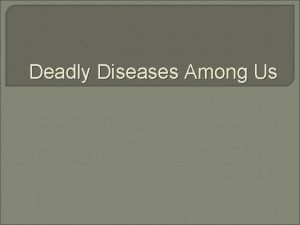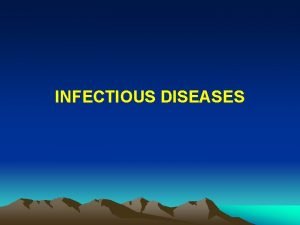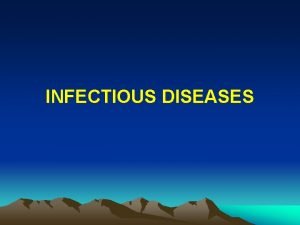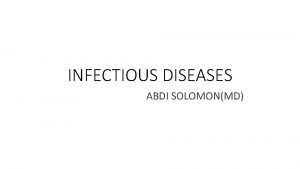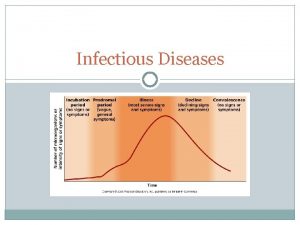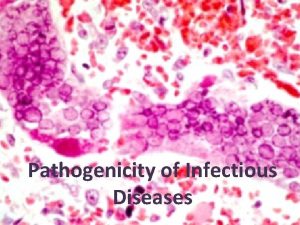Treatment of Some Infectious Diseases Treatment of Hepatic



![A. Interferons • Interferons [in-ter-FEER-on] are a family of naturally occurring, inducible glycoproteins that A. Interferons • Interferons [in-ter-FEER-on] are a family of naturally occurring, inducible glycoproteins that](https://slidetodoc.com/presentation_image_h/1f706afc72dcd971959907d996249fa7/image-4.jpg)




![C. Adefovir ü Adefovir dipivoxil [ah-DEF-o-veer die-pih-VOCKS-ill] is a nucleotide analog that is phosphorylated C. Adefovir ü Adefovir dipivoxil [ah-DEF-o-veer die-pih-VOCKS-ill] is a nucleotide analog that is phosphorylated](https://slidetodoc.com/presentation_image_h/1f706afc72dcd971959907d996249fa7/image-9.jpg)
![D. Entecavir • Entecavir [en-TECK-ah-veer] is a guanosine nucleoside analog for the treatment of D. Entecavir • Entecavir [en-TECK-ah-veer] is a guanosine nucleoside analog for the treatment of](https://slidetodoc.com/presentation_image_h/1f706afc72dcd971959907d996249fa7/image-10.jpg)
![E. Telbivudine • Telbivudine [tel-BIV-yoo-dine] is a thymidine analog that can be used in E. Telbivudine • Telbivudine [tel-BIV-yoo-dine] is a thymidine analog that can be used in](https://slidetodoc.com/presentation_image_h/1f706afc72dcd971959907d996249fa7/image-11.jpg)
![F. Tenofovir (TDF) • Tenofovir [te-NOE-fo-veer] is a nucleotide analog, namely, an acyclic nucleoside F. Tenofovir (TDF) • Tenofovir [te-NOE-fo-veer] is a nucleotide analog, namely, an acyclic nucleoside](https://slidetodoc.com/presentation_image_h/1f706afc72dcd971959907d996249fa7/image-12.jpg)
![• • G. Boceprevir and telaprevir Boceprevir [boe-SE-pre-vir] and telaprevir [tel-A-pre-vir] are the • • G. Boceprevir and telaprevir Boceprevir [boe-SE-pre-vir] and telaprevir [tel-A-pre-vir] are the](https://slidetodoc.com/presentation_image_h/1f706afc72dcd971959907d996249fa7/image-13.jpg)

![A. Pentamidine Antitrypanosomal Drugs • Pentamidine [pen-TAM-i-deen] is active against a variety of protozoal A. Pentamidine Antitrypanosomal Drugs • Pentamidine [pen-TAM-i-deen] is active against a variety of protozoal](https://slidetodoc.com/presentation_image_h/1f706afc72dcd971959907d996249fa7/image-15.jpg)


![B. Suramin • Suramin [SOO-ra-min] is used primarily in the first stage (without CNS B. Suramin • Suramin [SOO-ra-min] is used primarily in the first stage (without CNS](https://slidetodoc.com/presentation_image_h/1f706afc72dcd971959907d996249fa7/image-18.jpg)
![C. Melarsoprol ü Melarsoprol [mel-AR-so-prol], a trivalent arsenical compound, is used for the treatment C. Melarsoprol ü Melarsoprol [mel-AR-so-prol], a trivalent arsenical compound, is used for the treatment](https://slidetodoc.com/presentation_image_h/1f706afc72dcd971959907d996249fa7/image-19.jpg)

![D. Eflornithine • Eflornithine [ee-FLOOR-nih-theen] is an irreversible inhibitor of ornithine decarboxylase. Inhibition of D. Eflornithine • Eflornithine [ee-FLOOR-nih-theen] is an irreversible inhibitor of ornithine decarboxylase. Inhibition of](https://slidetodoc.com/presentation_image_h/1f706afc72dcd971959907d996249fa7/image-21.jpg)
![E. Nifurtimox • Nifurtimox [nye-FER-tim-oks] is used in the treatment of T. cruzi infections E. Nifurtimox • Nifurtimox [nye-FER-tim-oks] is used in the treatment of T. cruzi infections](https://slidetodoc.com/presentation_image_h/1f706afc72dcd971959907d996249fa7/image-22.jpg)

![F. Benznidazole • Benznidazole [benz-NI-da-zole] is a nitroimidazole derivative with a mechanism of action F. Benznidazole • Benznidazole [benz-NI-da-zole] is a nitroimidazole derivative with a mechanism of action](https://slidetodoc.com/presentation_image_h/1f706afc72dcd971959907d996249fa7/image-24.jpg)

![A. Sodium stibogluconate • The pentavalent antimonial sodium stibogluconate [stib-o-GLOOkoe-nate] is not effective in A. Sodium stibogluconate • The pentavalent antimonial sodium stibogluconate [stib-o-GLOOkoe-nate] is not effective in](https://slidetodoc.com/presentation_image_h/1f706afc72dcd971959907d996249fa7/image-26.jpg)
![B. Miltefosine ü Miltefosine [mil-te-FOE-zeen] is the first orally active drug for visceral leishmaniasis. B. Miltefosine ü Miltefosine [mil-te-FOE-zeen] is the first orally active drug for visceral leishmaniasis.](https://slidetodoc.com/presentation_image_h/1f706afc72dcd971959907d996249fa7/image-27.jpg)


![• Nitazoxanide [nye-ta-ZOX-a-nide], a nitrothiazole derivative, is also approved for the treatment of • Nitazoxanide [nye-ta-ZOX-a-nide], a nitrothiazole derivative, is also approved for the treatment of](https://slidetodoc.com/presentation_image_h/1f706afc72dcd971959907d996249fa7/image-30.jpg)
- Slides: 30

Treatment of Some Infectious Diseases

Treatment of Hepatic Viral Infections • The hepatitis viruses thus far identified (A, B, C, D, and E) each have a pathogenesis specifically involving replication in and destruction of hepatocytes. • hepatitis B (a DNA virus) and hepatitis C (an RNA virus) are the most common causes of chronic hepatitis, cirrhosis, and hepatocellular carcinoma are the only hepatic viral infections for which therapy is currently available. • Hepatitis A is a commonly encountered infection caused by oral ingestion of the virus, but it is not a chronic disease. • Chronic hepatitis B may be treated with peginterferon-α-2 a, which is injected subcutaneously once weekly. • Interferon-α-2 b injected intramuscularly or subcutaneously three times weekly is also useful in the treatment of hepatitis B, but peginterferon-α-2 a has similar or slightly better efficacy with improved tolerability.

• Oral therapy for chronic hepatitis B includes lamivudine, adefovir, entecavir, tenofovir, or telbivudine. • The preferred treatment for chronic hepatitis C is the combination of peginterferon-α-2 a or peginterferon-α-2 b plus ribavirin, which is more effective than the combination of standard interferons and ribavirin. • For genotype 1 chronic hepatitis C virus (HCV), an NS 3/4 A protease inhibitor (such as boceprevir or telaprevir) should be added to pegylated interferon and ribavirin.
![A Interferons Interferons interFEERon are a family of naturally occurring inducible glycoproteins that A. Interferons • Interferons [in-ter-FEER-on] are a family of naturally occurring, inducible glycoproteins that](https://slidetodoc.com/presentation_image_h/1f706afc72dcd971959907d996249fa7/image-4.jpg)
A. Interferons • Interferons [in-ter-FEER-on] are a family of naturally occurring, inducible glycoproteins that interfere with the ability of viruses to infect cells. • The interferons are synthesized by recombinant DNA technology. • At least three types of interferons exist—α, β, and γ. • One of the 15 interferon-α glycoproteins, interferon-α-2 b has been approved for treatment of hepatitis B and C. • In “pegylated” formulations, bis-monomethoxy polyethylene glycol has been covalently attached to either interferon-α-2 a or -α-2 b to increase the size of the molecule. The larger molecular size delays absorption from the injection site, lengthens the duration of action of the drug, and also decreases its clearance.

q. Mechanism of action: • The antiviral mechanism is incompletely understood. It appears to involve the induction of host cell enzymes that inhibit viral RNA translation, ultimately leading to the degradation of viral m. RNA and t. RNA. • Pharmacokinetics: Interferon is not active orally, but it may be administered intralesionally, subcutaneously, or intravenously. • Very little active compound is found in the plasma, and its presence is not correlated with clinical responses. Cellular uptake and metabolism by the liver and kidney account for the disappearance of interferon from the plasma. Negligible renal elimination occurs.

Adverse Effects • Adverse effects include flu-like symptoms, such as fever, chills, myalgias, arthralgias, and GI disturbances. fatigue and mental depression are common. • these symptoms subside with continued administration. the principal dose-limiting toxicities are bone marrow suppression, severe fatigue and weight loss, neurotoxicity characterized by somnolence and behavioral disturbances, autoimmune disorders such as thyroiditis and, rarely, cardiovascular problems such as heart failure. • Interferon may also potentiate myelosuppression caused by other bone marrow– suppressive agents.

Some approved indications for interferon

B. Lamivudine • This cytosine analog is an inhibitor of both hepatitis B virus (HBV) and human immunodeficiency virus (HIV) reverse transcriptases (RTs). ü Lamivudine [la-MI-vyoo-deen] must be phosphorylated by host cellular enzymes to the triphosphate (active) form. • This compound competitively inhibits HBV RNA-dependent DNA polymerase. As with many nucleotide analogs, the intracellular half-life of the triphosphate is many hours longer than its plasma halflife. The rate of resistance is high following long-term therapy with lamivudine. ü Lamivudine is well absorbed orally and is widely distributed. It is mainly excreted unchanged in urine. • Dose reductions are necessary when there is moderate renal insufficiency. Lamivudine is well tolerated, with rare occurrences of headache and dizziness.
![C Adefovir ü Adefovir dipivoxil ahDEFoveer diepihVOCKSill is a nucleotide analog that is phosphorylated C. Adefovir ü Adefovir dipivoxil [ah-DEF-o-veer die-pih-VOCKS-ill] is a nucleotide analog that is phosphorylated](https://slidetodoc.com/presentation_image_h/1f706afc72dcd971959907d996249fa7/image-9.jpg)
C. Adefovir ü Adefovir dipivoxil [ah-DEF-o-veer die-pih-VOCKS-ill] is a nucleotide analog that is phosphorylated by cellular kinases to adefovir diphosphate, which is then incorporated into viral DNA. ü This leads to termination of chain elongation and prevents replication of HBV. ü Adefovir is administered once a day and is renally excreted via glomerular filtration and tubular secretion. ü As with other agents, discontinuation of adefovir may result in severe exacerbation of hepatitis. v Nephrotoxicity may occur with chronic use, and the drug should be used cautiously in patients with existing renal dysfunction. Ø Adefovir may raise levels of tenofovir through competition for tubular secretion, and concurrent use should be avoided.
![D Entecavir Entecavir enTECKahveer is a guanosine nucleoside analog for the treatment of D. Entecavir • Entecavir [en-TECK-ah-veer] is a guanosine nucleoside analog for the treatment of](https://slidetodoc.com/presentation_image_h/1f706afc72dcd971959907d996249fa7/image-10.jpg)
D. Entecavir • Entecavir [en-TECK-ah-veer] is a guanosine nucleoside analog for the treatment of HBV infections. Following intracellular phosphorylation to the triphosphate, it competes with the natural substrate, deoxyguanosine triphosphate, for viral reverse transcription (RT). • Entecavir is effective against lamivudine-resistant strains of HBV and is dosed. The drug is primarily excreted unchanged in the urine and dosage adjustments are needed in renal dysfunction. • Concomitant use of drugs with renal toxicity should be avoided.
![E Telbivudine Telbivudine telBIVyoodine is a thymidine analog that can be used in E. Telbivudine • Telbivudine [tel-BIV-yoo-dine] is a thymidine analog that can be used in](https://slidetodoc.com/presentation_image_h/1f706afc72dcd971959907d996249fa7/image-11.jpg)
E. Telbivudine • Telbivudine [tel-BIV-yoo-dine] is a thymidine analog that can be used in the treatment of HBV. • Telbivudine is phosphorylated intracellularly to the triphosphate, which can either compete with endogenous thymidine triphosphate for incorporation into DNA or be incorporated into viral DNA, where it serves to terminate further elongation of the DNA chain. ü The drug is administered orally, once a day. • Telbivudine is eliminated by glomerular filtration as the unchanged drug. ü The dose must be adjusted in renal failure. ü Adverse reactions include fatigue, headache, diarrhea, and elevations in liver enzymes and creatine kinase.
![F Tenofovir TDF Tenofovir teNOEfoveer is a nucleotide analog namely an acyclic nucleoside F. Tenofovir (TDF) • Tenofovir [te-NOE-fo-veer] is a nucleotide analog, namely, an acyclic nucleoside](https://slidetodoc.com/presentation_image_h/1f706afc72dcd971959907d996249fa7/image-12.jpg)
F. Tenofovir (TDF) • Tenofovir [te-NOE-fo-veer] is a nucleotide analog, namely, an acyclic nucleoside phosphonate analog of adenosine 5′-monophosphate. • It is converted by cellular enzymes to the diphosphate, which is the inhibitor of HIV RT. • Cross-resistance with other nucleotide reverse transcriptase inhibitors (NRTIs) may occur. • Tenofovir has a long half-life, allowing once-daily dosing. • Most of the drug is recovered unchanged in the urine. • Serum creatinine must be monitored and doses adjusted in renal insufficiency. • GI complaints are frequent and include nausea and bloating
![G Boceprevir and telaprevir Boceprevir boeSEprevir and telaprevir telAprevir are the • • G. Boceprevir and telaprevir Boceprevir [boe-SE-pre-vir] and telaprevir [tel-A-pre-vir] are the](https://slidetodoc.com/presentation_image_h/1f706afc72dcd971959907d996249fa7/image-13.jpg)
• • G. Boceprevir and telaprevir Boceprevir [boe-SE-pre-vir] and telaprevir [tel-A-pre-vir] are the first oral direct-acting antiviral agents for the adjunctive treatment of chronic HCV genotype 1. These HCV NS 3/4 A serine protease inhibitors covalently and reversibly bind to the NS 3 protease active site, thus inhibiting viral replication in host cells. Both drugs are potent inhibitors of viral replication; however, they have a low barrier to resistance and, when used as monotherapy, resistance quickly develops. Therefore, boceprevir or telaprevir should be used in combination with peginterferon alfa and ribavirin in order to improve response rates and reduce the emergence of viral resistance. Boceprevir is administered with food to improve absorption. The absorption of telaprevir is enhanced when it is administered with non–low-fat food. The metabolism of boceprevir and telaprevir occurs via CYP 450 isoenzymes. Because both drugs are strong inhibitors of CYP 3 A 4/5 and are also partially metabolized by CYP 3 A 4/5, they have the potential for complex drug interactions. Common adverse events with boceprevir include anemia and dysgeusia. Telaprevir is associated with rash, anemia, and anorectal discomfort.

CHEMOTHERAPY FOR TRYPANOSOMIASIS • African trypanosomiasis (sleeping sickness) and American trypanosomiasis (also known as Chagas disease) are two chronic and, eventually, fatal diseases caused by species of Trypanosoma. • In African sleeping sickness, T. brucei gambiense and T. brucei rhodesiense initially live and grow in the blood. The parasite later invades the CNS, causing inflammation of the brain and spinal cord that produces the characteristic lethargy and, eventually, continuous sleep. • Chagas disease is caused by T. cruzi and is endemic in Central and South America.
![A Pentamidine Antitrypanosomal Drugs Pentamidine penTAMideen is active against a variety of protozoal A. Pentamidine Antitrypanosomal Drugs • Pentamidine [pen-TAM-i-deen] is active against a variety of protozoal](https://slidetodoc.com/presentation_image_h/1f706afc72dcd971959907d996249fa7/image-15.jpg)
A. Pentamidine Antitrypanosomal Drugs • Pentamidine [pen-TAM-i-deen] is active against a variety of protozoal infections, including African trypanosomiasis due to T. brucei gambiense, for which it is used to treat the first stage (hemolymphatic stage without CNS involvement). ü Pentamidine is also an alternative for prophylaxis or treatment of infections caused by Pneumocystis jirovecii. (P. jirovecii is an atypical fungus that causes pneumonia in immunocompromised patients, such as those with HIV infection). • Trimethoprim/sulfamethoxazole is preferred in the treatment of P. jirovecii infections; however, pentamidine is an alternative in individual who are allergic to sulfonamides. ü Pentamidine is also an alternative drug for the treatment of leishmaniasis.

q Mechanism of action: § T. brucei concentrates pentamidine by an energy-dependent, high-affinity uptake system. • Resistance is associated with inability to concentrate the drug. Although its mechanism of action has not been defined, evidence exists that the drug interferes with parasite synthesis of RNA, DNA, phospholipids, and proteins. • Pharmacokinetics: Pentamidine is administered intramuscularly or intravenously for the treatment of trypanosomiasis and pneumonia caused by P. jirovecii. • For prophylaxis of P. jirovecii pneumonia, pentamidine is administered via nebulizer. ü The drug distributes widely and is concentrated in the liver, kidney, adrenals, spleen, and lungs. ü Because it does not enter the CSF, it is ineffective against the second stage (CNS involvement) of trypanosomiasis. ü The drug is not metabolized, and it is excreted very slowly in the urine. Ø Adverse effects: Serious renal dysfunction may occur, which is reversible on discontinuation. Other adverse reactions include hyperkalemia, hypotension, pancreatitis, hypoglycemia, hyperglycemia, and diabetes.

Summary of Trypanosomiasis
![B Suramin Suramin SOOramin is used primarily in the first stage without CNS B. Suramin • Suramin [SOO-ra-min] is used primarily in the first stage (without CNS](https://slidetodoc.com/presentation_image_h/1f706afc72dcd971959907d996249fa7/image-18.jpg)
B. Suramin • Suramin [SOO-ra-min] is used primarily in the first stage (without CNS involvement) of African trypanosomiasis due to T. brucei rhodesiense. • It is very reactive and inhibits many enzymes, especially those involved in energy metabolism, which appears to be the mechanism correlated with trypanocidal activity. • Suramin must be injected intravenously. It binds to plasma proteins and does not penetrate the blood –brain barrier well. It has a long elimination half-life (more than 40 days) and is mainly excreted unchanged in the urine. • Although infrequent, adverse reactions include nausea and vomiting, shock and loss of consciousness, acute urticaria, and neurologic problems, such as paresthesia, photophobia, and hyperethesia of the hands and feet. • Renal insufficiency may occur but tends to resolve with discontinuation of treatment. • Acute hypersensitivity reactions may occur, and a test dose should be given prior to drug administration.
![C Melarsoprol ü Melarsoprol melARsoprol a trivalent arsenical compound is used for the treatment C. Melarsoprol ü Melarsoprol [mel-AR-so-prol], a trivalent arsenical compound, is used for the treatment](https://slidetodoc.com/presentation_image_h/1f706afc72dcd971959907d996249fa7/image-19.jpg)
C. Melarsoprol ü Melarsoprol [mel-AR-so-prol], a trivalent arsenical compound, is used for the treatment of African trypanosomal infections in the second stage (CNS involvement). Ø It is the only drug available for second stage trypanosomiasis due to T. brucei rhodesiense. • The drug reacts with sulfhydryl groups of various substances, including enzymes in both the organism and host. • Some resistance has been noted, and it may be due to decreased transporter uptake of the drug. • Melarsoprol is administered by slow IV injection and can be very irritating to the surrounding tissue. • Adequate trypanocidal concentrations appear in the CSF, making melarsoprol the agent of choice in the treatment of T. brucei rhodesiense, which rapidly invades the CNS. • The host readily oxidizes melarsoprol to a relatively nontoxic, pentavalent arsenic compound.

C. Melarsoprol • The drug has a very short half-life and is rapidly excreted in urine. ü The use of melarsoprol is limited by CNS toxicity. Reactive encephalopathy may occur, which can be fatal in 10% of cases. Ø Other adverse effects include peripheral neuropathy, hypertension, and albuminuria. Hypersensitivity reactions may also occur, and febrile reactions may follow injection. Ø Hemolytic anemia has been seen in patients with glucose-6 -phosphate dehydrogenase deficiency
![D Eflornithine Eflornithine eeFLOORnihtheen is an irreversible inhibitor of ornithine decarboxylase Inhibition of D. Eflornithine • Eflornithine [ee-FLOOR-nih-theen] is an irreversible inhibitor of ornithine decarboxylase. Inhibition of](https://slidetodoc.com/presentation_image_h/1f706afc72dcd971959907d996249fa7/image-21.jpg)
D. Eflornithine • Eflornithine [ee-FLOOR-nih-theen] is an irreversible inhibitor of ornithine decarboxylase. Inhibition of this enzyme halts the production of polyamines in the parasite, thereby leading to cessation of cell division. • The IV formulation of eflornithine is a first-line treatment for second- stage African trypanosomiasis caused by T. brucei gambiense. ü Topical eflornithine is used as a treatment for unwanted facial hair in women. • The short half-life of eflornithine necessitates frequent IV administration, making the treatment regimen difficult to follow. ü Eflornithine is less toxic than melarsoprol, although the drug is associated with anemia, seizures, and temporary hearing loss.
![E Nifurtimox Nifurtimox nyeFERtimoks is used in the treatment of T cruzi infections E. Nifurtimox • Nifurtimox [nye-FER-tim-oks] is used in the treatment of T. cruzi infections](https://slidetodoc.com/presentation_image_h/1f706afc72dcd971959907d996249fa7/image-22.jpg)
E. Nifurtimox • Nifurtimox [nye-FER-tim-oks] is used in the treatment of T. cruzi infections (Chagas disease), although treatment of the chronic stage of such infections has led to variable results. It may also be useful for the treatment of second-stage T. brucei gambiense in combination with eflornithine. ü Being a nitroaromatic compound, nifurtimox undergoes reduction and eventually generates intracellular oxygen radicals, such as superoxide radicals and hydrogen peroxide. ü These highly reactive radicals are toxic to T. cruzi. Nifurtimox is administered orally. • It is extensively metabolized, and the metabolites are excreted mainly in the urine. • Adverse effects are common following chronic administration, particularly among the elderly. • Major toxicities include hypersensitivity reactions (anaphylaxis, dermatitis) and gastrointestinal problems that may be severe enough to cause weight loss. • Peripheral neuropathy is relatively common, and headache and dizziness may also occur.

Generation of toxic intermediates by nifurtimox.
![F Benznidazole Benznidazole benzNIdazole is a nitroimidazole derivative with a mechanism of action F. Benznidazole • Benznidazole [benz-NI-da-zole] is a nitroimidazole derivative with a mechanism of action](https://slidetodoc.com/presentation_image_h/1f706afc72dcd971959907d996249fa7/image-24.jpg)
F. Benznidazole • Benznidazole [benz-NI-da-zole] is a nitroimidazole derivative with a mechanism of action similar to nifurtimox. • It tends to be better tolerated than nifurtimox and is an alternative for the treatment of Chagas disease. • Adverse effects include dermatitis, peripheral neuropathy, insomnia, and anorexia.

V. CHEMOTHERAPY FOR LEISHMANIASIS • There are three types of leishmaniasis: cutaneous, mucocutaneous, and visceral. • In the visceral type (liver and spleen), the parasite is in the bloodstream and can cause very serious problems. • Leishmaniasis is transmitted from animals to humans (and between humans) by the bite of infected sandflies. • The diagnosis is established by demonstrating the parasite in biopsy material and skin lesions. • For visceral leishmaniasis, parenteral treatments may include amphotericin B and pentavalent antimonials, such as sodium stibogluconate, with pentamidine and paromomycin as alternative agents. • Miltefosine is an orally active agent for visceral leishmaniasis. • The choice of agent depends on the species of Leishmania, host factors, and resistance patterns noted in area of the world where the infection is acquired.
![A Sodium stibogluconate The pentavalent antimonial sodium stibogluconate stiboGLOOkoenate is not effective in A. Sodium stibogluconate • The pentavalent antimonial sodium stibogluconate [stib-o-GLOOkoe-nate] is not effective in](https://slidetodoc.com/presentation_image_h/1f706afc72dcd971959907d996249fa7/image-26.jpg)
A. Sodium stibogluconate • The pentavalent antimonial sodium stibogluconate [stib-o-GLOOkoe-nate] is not effective in vitro. • Therefore, it has been proposed that reduction to the trivalent antimonial compound is essential for activity. • The exact mechanism of action has not been determined. Because it is not absorbed after oral administration, sodium stibogluconate must be administered parenterally, and it is distributed in the extravascular compartment. • Metabolism is minimal, and the drug is excreted in urine. • Adverse effects include injection site pain, pancreatitis, elevated liver enzymes, arthralgias, myalgias, gastrointestinal upset, and cardiac arrhythmias. • Renal and hepatic function should be monitored periodically.
![B Miltefosine ü Miltefosine milteFOEzeen is the first orally active drug for visceral leishmaniasis B. Miltefosine ü Miltefosine [mil-te-FOE-zeen] is the first orally active drug for visceral leishmaniasis.](https://slidetodoc.com/presentation_image_h/1f706afc72dcd971959907d996249fa7/image-27.jpg)
B. Miltefosine ü Miltefosine [mil-te-FOE-zeen] is the first orally active drug for visceral leishmaniasis. It may also have some activity against cutaneous and mucocutaneous forms of the disease. • The precise mechanism of action is not known, but miltefosine appears to interfere with phospholipids in the parasitic cell membrane to induce apoptosis. • Nausea and vomiting are common adverse reactions. • The drug is teratogenic and should be avoided in pregnancy.

VI. CHEMOTHERAPY FOR TOXOPLASMOSIS • One of the most common infections in humans is caused by the protozoan T. gondii, which is transmitted to humans when they consume raw or inadequately cooked infected meat. • An infected pregnant woman can transmit the organism to her fetus. • Cats are the only animals that shed oocysts, which can infect other animals as well as humans. • The treatment of choice for this condition is a combination of sulfadiazine and pyrimethamine. • Leucovorin is commonly administered to protect against folate deficiency. At the first appearance of a rash, pyrimethamine should be discontinued, because hypersensitivity to this drug can be severe. • Pyrimethamine with clindamycin, or the combination of trimethoprim and sulfamethoxazole, are alternative treatments. • Trimethoprim/sulfamethoxazole is used for prophylaxis against toxoplasmosis (as well as P. jirovecii) in immunocompromised patients.

Chemotherapy For Giardiasis • Giardia lamblia is the most commonly diagnosed intestinal parasite in the United States. • It has two life cycle stages: the binucleate trophozoite with four flagella and the drug-resistant, fournucleate cyst. • Ingestion, usually from contaminated drinking water, leads to infection. • The trophozoites exist in the small intestine and divide by binary fission. • Occasionally, cysts are formed that pass out in stools. • Although some infections are asymptomatic, severe diarrhea can occur, which can be very serious in immunocompromised patients. • The treatment of choice is oral metronidazole for 5 days. • An alternative is tinidazole, which is as effective as metronidazole in the treatment of giardiasis. This agent is administered orally as a single dose.
![Nitazoxanide nyetaZOXanide a nitrothiazole derivative is also approved for the treatment of • Nitazoxanide [nye-ta-ZOX-a-nide], a nitrothiazole derivative, is also approved for the treatment of](https://slidetodoc.com/presentation_image_h/1f706afc72dcd971959907d996249fa7/image-30.jpg)
• Nitazoxanide [nye-ta-ZOX-a-nide], a nitrothiazole derivative, is also approved for the treatment of giardiasis. • Nitazoxanide may also be used for cryptosporidiosis (a diarrheal illness most commonly seen in immunocompromised patients) caused by the parasite Cryptosporidium parvum. • For giardiasis, nitazoxanide is administered as a 3 -day course of oral therapy. • The anthelmintic drug albendazole may also be efficacious for giardiasis. • paromomycin is sometimes used for treatment of giardiasis in pregnant patients.
 Epidemiological triad of malaria
Epidemiological triad of malaria Certain infectious and parasitic diseases
Certain infectious and parasitic diseases Lactulose mechanism of action
Lactulose mechanism of action Infectious disease quality controls
Infectious disease quality controls Hennepin county infectious disease manual
Hennepin county infectious disease manual Infectious canine hepatitis in dogs
Infectious canine hepatitis in dogs Infectious nucleic acid
Infectious nucleic acid Periods of infectious disease
Periods of infectious disease Hpps symbols
Hpps symbols Stridor
Stridor Lead poisoning
Lead poisoning Chapter 26 infectious disease prevention and control
Chapter 26 infectious disease prevention and control Quizlet
Quizlet Smallest infectious agent
Smallest infectious agent Infectious waste in hiligaynon
Infectious waste in hiligaynon Ebv
Ebv Infectious disease
Infectious disease Stages of infectious disease
Stages of infectious disease Infectious stunting syndrome
Infectious stunting syndrome Papillomitosis
Papillomitosis Force and motion
Force and motion They say it only takes a little faith to move a mountain
They say it only takes a little faith to move a mountain Some say the world will end in fire some say in ice
Some say the world will end in fire some say in ice God when you choose to leave mountains unmovable
God when you choose to leave mountains unmovable Some say the world will end in fire some say in ice
Some say the world will end in fire some say in ice Cakecountable or uncountable
Cakecountable or uncountable Some trust in chariots and some in horses song
Some trust in chariots and some in horses song Hepatic impairment classification
Hepatic impairment classification Hepatic encephalopathy stages
Hepatic encephalopathy stages Defecation
Defecation Types of cirrhosis
Types of cirrhosis









